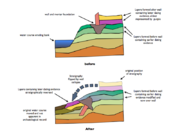
Reverse stratigraphy
Encyclopedia

Stratigraphy
Stratigraphy, a branch of geology, studies rock layers and layering . It is primarily used in the study of sedimentary and layered volcanic rocks....
(sometimes known as inverted stratigraphy) is the result of a process whereby one sediment is unearthed by human or natural actions and moved elsewhere, whereby the latest material will be deposited on the bottom of the new sediment, and progressively earlier material will be deposited higher and higher in the stratigraphy. Such events can be triggered by rockslides, treethrows, or other events which cause the strata of a deposit to be flipped or reversed .In Archeological excavations a common cause of inversions in the stratigraphy is the collapse of walls on river banks or other raised mounds where deposits which have been cut through behind the wall prior to collapse slip over the collapsed structure resulting in the structure being under the deposits that originated earlier in time. In this case care must be taken to re-context
Archaeological context
In archaeology, not only the context of a discovery is a significant fact, but the formation of the context is as well. An archaeological context is an event in time which has been preserved in the archaeological record. The cutting of a pit or ditch in the past is a context, whilst the material...
the slipped deposits so the event of slippage appears in the correct place stratigraphically in the Harris matrix
Harris matrix
The Harris matrix is a tool used to depict the temporal succession of archaeological contexts and thus the sequence of deposition on a 'dry land' archaeological site. The matrix reflects the relative position and stratigraphic contacts of observable stratigraphic units, or contexts. The Matrix was...
. There are numerous process that can reverse the stratigraphy or more accurately redeposit it. Many rely on slope processes, however other instances where deposits containing material later than overlying deposits occur in such features as drains or hypocaust systems. In these instances a clear understanding of the direction of "UP" and site formation processes is essential. Drains or hypocaust systems often have later material deposited within them during their "use", which may be much much later than either their initial construction or indeed the construction, use and disuse of the floors above them.
See also
- Excavation
- Archaeological contextArchaeological contextIn archaeology, not only the context of a discovery is a significant fact, but the formation of the context is as well. An archaeological context is an event in time which has been preserved in the archaeological record. The cutting of a pit or ditch in the past is a context, whilst the material...
- Archaeological associationArchaeological associationAssociation in archaeology has more than one meaning and is confusing to the layman. Archaeology has been critiqued as a soft science with a somewhat poor standardization of terms.-Finds and objects:...
- Archaeological sectionArchaeological sectionIn archaeology a section is a view in part of the archaeological sequence showing it in the vertical plane, as a cross section, and thereby illustrating its profile and stratigraphy. This may make it easier to view and interpret as it developed over time....
- Feature (archaeology)Feature (archaeology)Feature in archaeology and especially excavation has several different but allied meanings. A feature is a collection of one or more contexts representing some human non-portable activity that generally has a vertical characteristic to it in relation to site stratigraphy. Examples of features are...
- Single context recordingSingle context recordingSingle context recording was initially developed by Ed Harris and Patrick Ottaway in 1976, from a suggestion by Lawrence Keene. It was further developed by the Department of Urban Archaeology from where it was then exported, in the mid 1980s by Pete Clarke to the Scottish Urban Archaeological...
- Harris matrixHarris matrixThe Harris matrix is a tool used to depict the temporal succession of archaeological contexts and thus the sequence of deposition on a 'dry land' archaeological site. The matrix reflects the relative position and stratigraphic contacts of observable stratigraphic units, or contexts. The Matrix was...

